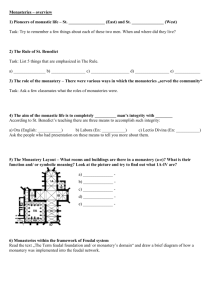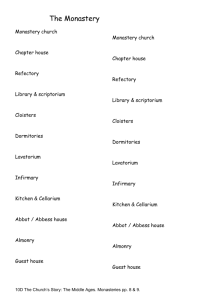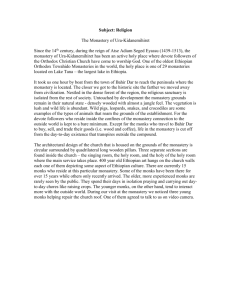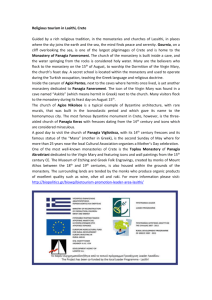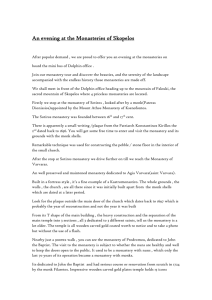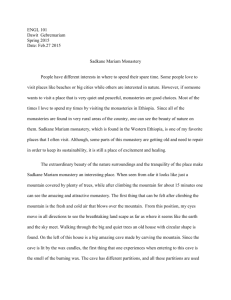other monasteries
advertisement
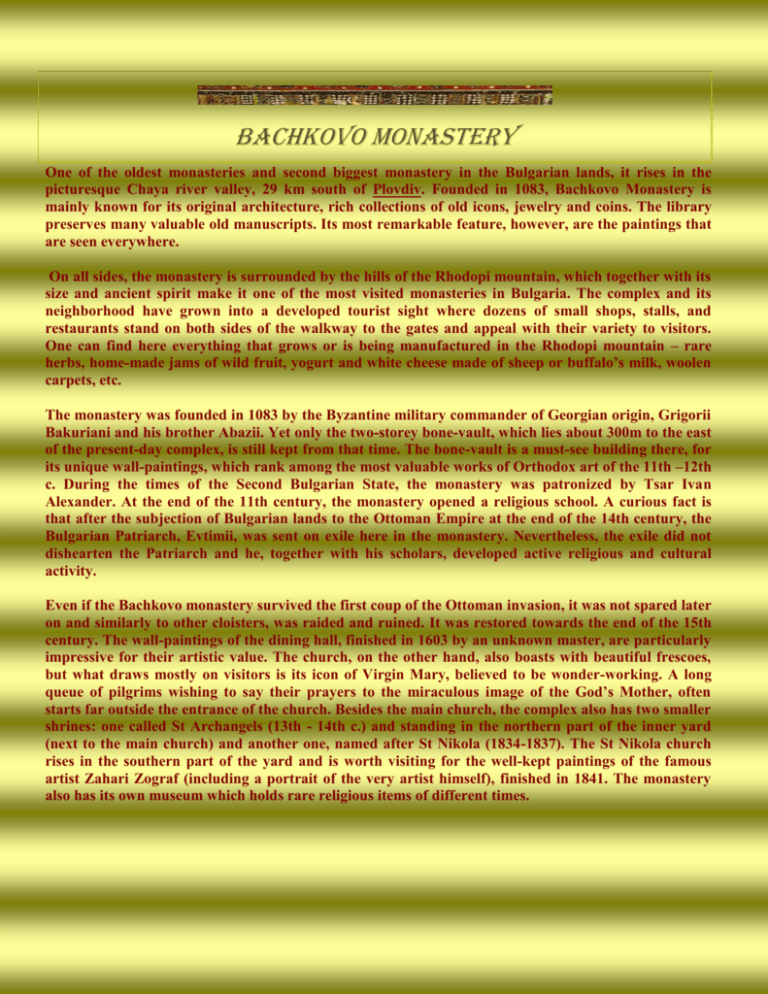
Bachkovo Monastery One of the oldest monasteries and second biggest monastery in the Bulgarian lands, it rises in the picturesque Chaya river valley, 29 km south of Plovdiv. Founded in 1083, Bachkovo Monastery is mainly known for its original architecture, rich collections of old icons, jewelry and coins. The library preserves many valuable old manuscripts. Its most remarkable feature, however, are the paintings that are seen everywhere. On all sides, the monastery is surrounded by the hills of the Rhodopi mountain, which together with its size and ancient spirit make it one of the most visited monasteries in Bulgaria. The complex and its neighborhood have grown into a developed tourist sight where dozens of small shops, stalls, and restaurants stand on both sides of the walkway to the gates and appeal with their variety to visitors. One can find here everything that grows or is being manufactured in the Rhodopi mountain – rare herbs, home-made jams of wild fruit, yogurt and white cheese made of sheep or buffalo’s milk, woolen carpets, etc. The monastery was founded in 1083 by the Byzantine military commander of Georgian origin, Grigorii Bakuriani and his brother Abazii. Yet only the two-storey bone-vault, which lies about 300m to the east of the present-day complex, is still kept from that time. The bone-vault is a must-see building there, for its unique wall-paintings, which rank among the most valuable works of Orthodox art of the 11th –12th c. During the times of the Second Bulgarian State, the monastery was patronized by Tsar Ivan Alexander. At the end of the 11th century, the monastery opened a religious school. A curious fact is that after the subjection of Bulgarian lands to the Ottoman Empire at the end of the 14th century, the Bulgarian Patriarch, Evtimii, was sent on exile here in the monastery. Nevertheless, the exile did not dishearten the Patriarch and he, together with his scholars, developed active religious and cultural activity. Even if the Bachkovo monastery survived the first coup of the Ottoman invasion, it was not spared later on and similarly to other cloisters, was raided and ruined. It was restored towards the end of the 15th century. The wall-paintings of the dining hall, finished in 1603 by an unknown master, are particularly impressive for their artistic value. The church, on the other hand, also boasts with beautiful frescoes, but what draws mostly on visitors is its icon of Virgin Mary, believed to be wonder-working. A long queue of pilgrims wishing to say their prayers to the miraculous image of the God’s Mother, often starts far outside the entrance of the church. Besides the main church, the complex also has two smaller shrines: one called St Archangels (13th - 14th c.) and standing in the northern part of the inner yard (next to the main church) and another one, named after St Nikola (1834-1837). The St Nikola church rises in the southern part of the yard and is worth visiting for the well-kept paintings of the famous artist Zahari Zograf (including a portrait of the very artist himself), finished in 1841. The monastery also has its own museum which holds rare religious items of different times. DRYANOVO Monastery The founders were two rebel boyars of the then-capital city of Turnovo –the Assen and Petar brothers. In the 14th century, the holy place sheltered many monks. At the beginning of the 15th century, the monastery was destroyed by the invading Ottoman troops. Later on, it was reconstructed on a neighbouring site, but the fate of this monastery was no happier than that of its predecessor. The Dryanovo monastery was restored anew at the end of the 17th century, this time in its present-day place. The main church of that time had a single nave and was half-hidden in the ground. It was standing very near to the present-day church. The renovation of the monastery was started at the time of father Rafail, during the 40es of the 19th century. The current residential buildings rising from the side of the river were built at that time, while the new church was finished in 1845. Gradually, the renovated Dryanovo monastery became a religious and cultural centre and one of the largest and well-kept cloisters in the region of Turnovo. Dryanovo monks took active part in the Bulgarians’ uprisings and plots against the Ottoman rule. One of the main quarters of the Bulgarian Central Revolutionary Committee in Turnovo was located exactly in the monastery and famous rebel leaders such as Vassil Levski and Georgi Izmirliev were often to be found there. There was a secret storeroom for food and arms, which was the reason why rebel leaders Priest Hariton and Bacho Kiro used the monastery as their fortress at the time of the April uprising. Only a small number of the Bulgarian rebels survived the battle with the Turkish troops, while the monastery was again set on fire with the church being the only building that is left relatively intact. The most recent reconstruction of the complex was carried out shortly after the Liberation. A new residential part and a museum were added to the existing buildings. ROZHEN Monastery The Rozhen monastery is situated about 5km away from the small town of Melnik up in the lower part of the Pirin mountain. It offers an amazing view to the peaks of the Pirin and Belasitsa mountains, and the famous ‘mels’ of Melnik – the latter being pyramid-like hills around the town, formed by the erosion of clay . The Rozhen monastery is the biggest sanctuary in the Pirin region and one of the few Bulgarian monasteries of the Middle Ages, which has survived relatively intact up to present days. According to annals kept in Atone, Greece, the monastery dates back at least to 890 AC – for comparison, the biggest monastery in Bulgaria, the Rila monastery, is believed to have started functioning in 917 AC. The church of the monastery, named St Birth of Virgin Mary, later gave its name to the nearby village of Rozhen (Rozhen coming from the root of the Bulgarian word for birth, ‘Rozhdenie’). During the rule of Despot Aleksii Slav, governor of the region at the time of Tzar Kaloyan (1197-1207) and Kaloyan’s nephew, the monastery’s complex was enriched with a number of buildings. The monastery was destroyed by fire in the early 17th century, but was rebuilt in the beginning of the 18th century with the financial support of wealthy Bulgarians from all over the country. The reconstruction started in 1715, with the church having been entirely renovated in 1732. The monastery saw its apogee in the 19th century when it served as a regional spiritual centre and had numerous real estate holdings in the surrounding area. The end of the monastery’s heyday was put by a famous local revolutionary, Yane Sandanski, who together with his relatives seized real estate properties of the monastery. Nowadays, the monastery is well maintained and open to visitors all around the year. The monastery’s holiday is on September 8, when people from all over the area gather to take part in the celebrations. The monastery has an irregular 6-angle form, with residential buildings surrounding a beautiful yard with the church lying in the centre of it. All the monastery’s buildings were constructed in different periods, with the monks’ dining room, the bone-vault and several farm buildings being the oldest ones, dating back to the period before the fire in the 17th century. Besides well preserved wall paintings, the monastery is famous for its stained glass (the oldest of its type preserved till present days) and unique woodcarvings. As other monasteries, the Rozhen one also has its miraculous icon-protector, of Virgin Mary, which is kept in an arc in one of the chapels of the complex. According to the legend, the icon is one of the few copies of a sacred icon, owned by a widow of Nikea (Greece). During the times of the Byzantine’s emperor Theophilus, famous for his persecution of icon worship, the widow threw the icon in the waters in order to avoid its being destroyed by the emperor. The icon did not sink but sailed for years, until in 999 it reached the gates of the Iviron monastery in Greece. TROYAN Monastery Troyan monastery, “Assumption of Virgin Mary”, lies 10 km to the southeast of the old Balkan town of Troyan, in the skirts of the Balkan mountain range. Built at about 400 meters above sea level, the biggest monastery in the Balkan mountains is surrounded by beautiful forests and the Cherni Osam river, which gives a particular charm to the place. The monastery’s complex is quite developed as a tourist site with plenty of shopping outlets, restaurants and entertainment facilities in the neighbourhood. The first traces of religious life in the area date back to the end of the 16th century, or according to some – to an even earlier time around the end of the second Bulgarian state (turn of the 14th century), when the very town of Troyan was founded. According to the monastery’s chronicles, kept by an unknown monk, the monastery was founded by a hermit who came to the place and built himself a simple cottage some years after the fall of the second Bulgarian state. The monk quickly won the respect of the local people who started visiting him for prayer and advice. Later on, he built a church consecrated to the Holy Virgin. Between the time of its establishment and 1830, the monastery lived through difficult times, when it was often raided and destroyed, while its monks – killed. The monastery’s dependence on the Greek bishops of the Lovech eparchy, who used its lands and forests for their own enrichment, added to the monastery’s troubles. The solution to the latter problem came in 1830, when a delegation of monks visited the Patriarchy in Constantinople (present-day Istanbul) to present a request for religious, administrative and economic independence of the Troyan monastery. With the help of a supportive letter by the metropolitan bishop of Troyan, Ilarion, the monks achieved what they went to Constantinople for. A special Charter, dated December 4, 1830 and signed by the ecumenical Patriarch Constandios, gave the monastery the desired autonomy, by declaring it “stauropegial” – meaning that it was exempted from the jurisdiction of the local bishop of Lovech and was directly subjected to the Patriarchate of Constantinople. From that point onward, the monastery has expanded and developed into a cultural and religious centre. The monastery is built in the style of the Bulgarian Renaissance. The chapel of St Nikolay the MiracleWorker is the oldest but best preserved religious building in the area, though it lies outside the presentday monastery complex, at about half an hour walk south of it. The monastery’s church, “Assumption of Virgin Mary”, was built in 1835. Though its parts were built by various masters at different times, the monastery is remarkable for its harmony. The monastery’s dwellings are 3 and 4-storeyed, with long open verandas looking to the inner yard and columns and parapets in the style of old Bulgarian cell-schools. The frescoes of the monastery and the church were painted in 1847-1849 by the famous Bulgarian artist, Zahari Zograf from the Samokov school of art and iconography. The icons of the church represent in their majority works by other masters of the Samokov school, including Zahari’s brother, Dimitar Zograf. Bearing in mind that Zahari and his schoolmates painted a large number of the frescoes at still-preserved monasteries, those at the Troyan monastery remind of many other places. Nevertheless, the ornamentation of the Troyan monastery is more lavish with more Baroque branches with leaves and blossoms. Similarly to the other monasteries at which he was employed here again Zahari painted his own portrait side by side with the portrait of the abbot. Another noteworthy portrait is the group one at the altar, depicting all the 27 monks that lived in the monastery at that time. An interesting painting, which in fact does not fit in the cannons of monastery frescoes, is the one on an outer wall of the living buildings. Zahari Zograf depicted a lion and an elephant, which were to symbolise Bulgarian strength and patience, respectively, during the long Ottoman rule. The wood carved iconostasis of the church, made entirely of walnut is also impressive. Similarly to other Bulgarian monasteries, this one also has its miraculous icon, which arrived at the monastery at the time of its establishment, namely the icon of the Three-handed Holy Virgin. According to the story, the icon was donated by a monk who on his way from Mt Athos to present-day Romania learnt about the hermit who lived close to Troyan and dropped by to spend some time with him. Besides its religious role, the monastery great Bulgarian writers, teachers and translators, including historians such as the monk Spirodon, author of the second book on the Bulgarian history (1792) lived there. It was also linked to the Bulgarians’ struggle against the Ottoman rule. Similarly to other monasteries, the Troyan one also hosted frequently the famous Bulgarian Apostle of Freedom, Vassil Levski. The latter formed revolutionary committees not only in the town of Troyan, but also at the monastery itself. The monastery’s secret committee numbered about 80 monks and was headed by archimandrite Makari. During that time (mid-19th century), the production of books at the monastery declined, but this was only at the expense of the monks’ preoccupation with the procurement of arms. During the Liberation Russian-Turkish war, Makari transformed the monastery into a field hospital for Russian soldiers and provided the Russians with all possible assistance.

